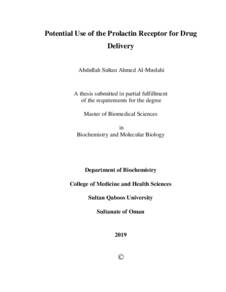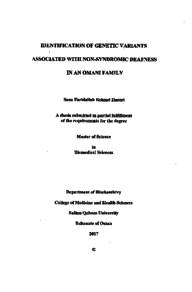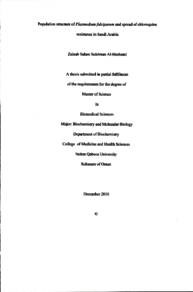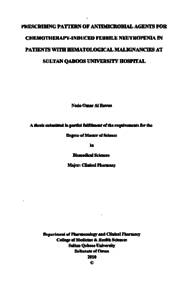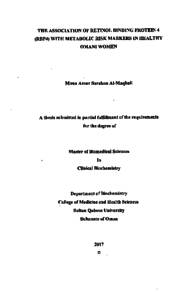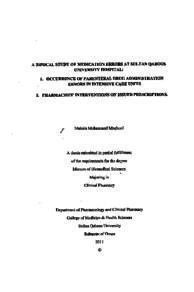Document
.Potential use of the prolactin receptor for drug delivery
Publisher
Sultan Qaboos University
Gregorian
2019
Language
English
Subject
English abstract
Introduction: Compounds blocking the prolactin receptor (PRLR) have not yet reached the clinic. There are however several observations supporting a future use of PRLR antagonist (PRLRA) for tumor treatments.Many drug have been used for cancer treatment and they are commenly associated with sever side effect, such a drug is Maytansine (DM1), a cytotoxic drug against cancer cells with neurotoxicity and multiple adverse effects on the gastrointestinal tract. Research pointed out the need for improved drugs that specifically deliver cancer drugs to the tumor aimed to be treated. Indeed, one has tested DM1 conjugated to a mono-clonal antibody to achive a tissue- specific-therapy.
Aim: This study aimed to investigate the potential use the PRLR for drug delivery. A PRLR antagonist (PRLRA) and DM1 conjugated to PRLRA (PRLRA-ABD-DM)1 were tested on PRLR positive cancer cells.
Methods: MCF7, U251, OV2008, OVSAHO and SKOV3 cell lines were screened for PRLR at mRNA and protein levels. MCF7 and U251 were selected and different read- outs were utilized: for PRL and PRLRA binding and internalization assay, phophorylation assay, effect on cell viability of PRLRA/PRLRA-ABD-DM1 using PRLR positive cancer cells.
Results: MCF7 cells showed the highest levels of PRLR mRNA and PRLR protein followed by U251 cells. OVSAHO, SKOV3 and OV2008 showed low PRLR levels. We found that PRL and PRLRA binds to PRLR in the selected cells. Under the conditions used, we were not able to demonstrate clear effects of PRL on the viability of the selected cell lines. Treatment with PRLRA showed no effect on U251 cells but showed a significant effects at high doses in MCF7 cells. On the other hand, PRLRA-ABD- DM1 showed a significant decline in viability of both cell lines with IC50 of 82.9 nM and 70 nM for MCF7 and U251 respectively.
Conclusion: Since the PRLRA-ABD-DM1 compound binds efficiently to the PRLR, it has the potential to provide a novel approach for anti-cancer treatment. Our work has defined cell systems and methods that are suitable to test for the bioactivity the PRLRA- ABD-DM1 compound. Although work remains to clearly demonstrate a PRLR dependent uptake of the DM1 conjugate, we have begun to optimize experimental systems to document if the PRLR is a suitable candidate to target and internalize cancer drugs.
Member of
Resource URL
Arabic abstract
مقدمة: البرولاكتين هرمون عديد البيتيد متكون من 199 حمض أميني. يرتبط البرولاكتين يمستقبلات البرولاكتين على غشاء الخلية. وجدت الدراسات أنه من المحتمل جدا أن يكون البرولاكتين ومستقبلاته عامل مهم في تطور ونمو العديد من أنواع السرطانات کسرطانات المبايض والثدي والبروستاتا والأورام الأرومية الدينية متعددة الأشكال في المقابل، يعتبر عقار الميتانسين (DM1) من العقارات الفعالة ضد الخلايا السرطانية إلا أنه مصحوب بالعديد من الأعراض الجانبية كالسمية العصبية والاثار السلبية على الجهاز الهضمي. العديد من الأدوية المصادق عليها سريرية تستخدم الميتانسين مرتبطأ بأجسام مضادة تستهدف علامات على خلايا سرطانية محددة كعقار ترستزوماب إمتانسين الذي يستهدف سرطان الثدي الموجب لمستقيت عامل نمو البشرة 2. تم تطوير متآلف، محتمل كمضاد لسرطان يستهدف الخلايا السرطانية الموجية المستقبلات البرولاكتين. يتكون المتألق، من مثبط لمستقبل البرولاكتين مربوطا بنطاق الارتباط اليومين موصولا بعقار الميتاتسين.
الأهداف: تهدف هذه الدراسة لاختبار فعالية مستقبلات البرولاكتين كناقل دوائی مخصص و أيضا الاختبار فعالية المتألف على الخلايا الموجية لمستقبلات البرولاكتين.
الطريقة: تم مسح العديد من سلالات الخلايا السرطانية كسرطان الثدي (MCF7) والمبيض ( , OV2008, OVSAHO SKOV3) والأورام الأرومية الديقية (U251) لمعرفة التعبير الجيني لمستقبلات البرولاكتين وأيضا على مستوى البروتين. تم اختيار نوعين من الخلايا واختبار عدة مكونات عليها مثل تأثير البرولاكتين ومثبط مستقبلات البرولاكتين على بقاء الخلايا كذلك تمت دراسة إمكانية ارتياط المركيين بمستقيات البرولاكتين. وأخيرا تم اختيار المتألق على الخلايا الدراسة تأثيره على بقاءها.
النتائج: أظهرت النتائج أن خلايا سرطان الثدي تملك أكبر كمية من مستقبلات البرولاكتين على مستوى التعبير الجيني والبروتينى متبوعة بخلايا الورم الأرومي الديقي. خلايا سرطان المبايض لم تظهر كمية وافرة من مستقبلات البرولاكتين تمت مواصلة التجارب مع خلايا سرطان الثدي والورم الأرومي البقي. التجارب أظهرت أن البرولاكتين حقز بقاء الورم الأرومي الديقي لكنه لم أي تأثير على بقاء خلايا سرطان الثدي, أما متبط مستقبلات البرولاكتين أظهر فعالية في خلايا سرطان الثدي وليس في الورم الأرومي الديقي المتألف أظهر تأثيرا محليرة على كلا النوعين من الخلايا ولكنه يفتقر إلى التخصصية.
الخاتمة: المتألف يرتبط بكفاءة على مستقبلات البرولاكتين ولكنه يحتاج لدراسة أعمق ليحك الأسباب التي جعلته يفتقر إلى التخصصية. تشمل هذه الأسباب احتمالية تأثر المتآلف بمواد ملوئة كبواقي من عملية الإنتاج أيضا احتمالية انفصال العقار (DM1) من المتألف أو تحلل المتألق عند تعرضه لظروف استزراع الخلايا۔
الأهداف: تهدف هذه الدراسة لاختبار فعالية مستقبلات البرولاكتين كناقل دوائی مخصص و أيضا الاختبار فعالية المتألف على الخلايا الموجية لمستقبلات البرولاكتين.
الطريقة: تم مسح العديد من سلالات الخلايا السرطانية كسرطان الثدي (MCF7) والمبيض ( , OV2008, OVSAHO SKOV3) والأورام الأرومية الديقية (U251) لمعرفة التعبير الجيني لمستقبلات البرولاكتين وأيضا على مستوى البروتين. تم اختيار نوعين من الخلايا واختبار عدة مكونات عليها مثل تأثير البرولاكتين ومثبط مستقبلات البرولاكتين على بقاء الخلايا كذلك تمت دراسة إمكانية ارتياط المركيين بمستقيات البرولاكتين. وأخيرا تم اختيار المتألق على الخلايا الدراسة تأثيره على بقاءها.
النتائج: أظهرت النتائج أن خلايا سرطان الثدي تملك أكبر كمية من مستقبلات البرولاكتين على مستوى التعبير الجيني والبروتينى متبوعة بخلايا الورم الأرومي الديقي. خلايا سرطان المبايض لم تظهر كمية وافرة من مستقبلات البرولاكتين تمت مواصلة التجارب مع خلايا سرطان الثدي والورم الأرومي البقي. التجارب أظهرت أن البرولاكتين حقز بقاء الورم الأرومي الديقي لكنه لم أي تأثير على بقاء خلايا سرطان الثدي, أما متبط مستقبلات البرولاكتين أظهر فعالية في خلايا سرطان الثدي وليس في الورم الأرومي الديقي المتألف أظهر تأثيرا محليرة على كلا النوعين من الخلايا ولكنه يفتقر إلى التخصصية.
الخاتمة: المتألف يرتبط بكفاءة على مستقبلات البرولاكتين ولكنه يحتاج لدراسة أعمق ليحك الأسباب التي جعلته يفتقر إلى التخصصية. تشمل هذه الأسباب احتمالية تأثر المتآلف بمواد ملوئة كبواقي من عملية الإنتاج أيضا احتمالية انفصال العقار (DM1) من المتألف أو تحلل المتألق عند تعرضه لظروف استزراع الخلايا۔
Category
Theses and Dissertations

